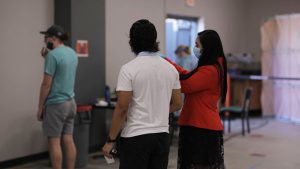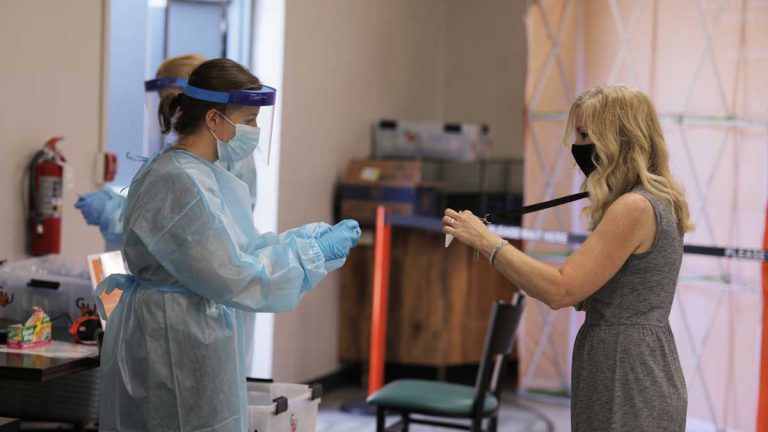GREENVILLE – A private college in southern Illinois is working with the University of Illinois to evaluate the effectiveness of the U of I’s COVID-19 Shield program on containing the spread of the virus at a small, rural campus.
The program relies on a rapid, saliva-based test developed by U of I researchers, as well as epidemiological modeling and a strategy to rapidly communicate test results and isolate or quarantine those who are sick or have been exposed.
The saliva tests are being used for mandatory frequent testing on the U of I’s Urbana, Springfield and Chicago campuses, which are in mid-sized and large cities.
In order to study the Shield program’s effectiveness on a small campus in a rural community, the U of I is partnering with Greenville University, located about 50 miles east of St. Louis.
The campus has about 700 students, plus a few hundred employees, and since mid-August, everyone has been tested twice a week with samples sent to the U of I’s Urbana labs for analysis, says Greenville President Suzanne Davis.
Davis says the research partnership with U of I began after a series of conversations she had over the summer with U of I System President Tim Killeen.
She says the testing and mitigation program is possible thanks to a state grant awarded to the Bond County health department, which allowed them to hire staff to run the testing site and do contact tracing.
“This has actually been a full community effort,” she says. “We’ve worked with our local health officials, but also with our local hospital system throughout the press, many of our regional leaders… We’re just a tight-knit smaller county.”

Greenville has identified about a half dozen COVID-19 cases since testing began in mid-August.
Davis says she’s optimistic that Greenville’s testing and mitigation strategies will allow the campus to remain open.
Geet Vanaik, Dean of International Affairs at Greenville, is overseeing the campus’ testing efforts. She spoke with Illinois Newsroom about the campus’ rollout of the Shield program.
This interview has been lightly edited and condensed for length and clarity.
Christien Herman: How is the COVID-19 testing program going at Greenville?
Geet Vanaik: We’re really putting in the four pillars for testing. So, not only do you have to test, but you have to wear your mask, you have to keep six feet distance (from others), and then test twice a week. And also, we’re doing contact tracing.
We’ve gotten a lot of encouragement from our students, because they’re very excited to see testing on a small campus. They did not expect it.
And the only way we’re able to do this, actually, is because of our partnership with the Bond County Health Department. They have really come behind us in this pilot and supported us to make this a reality.
CH: So, the sample collection is done there at Greenville University. But then the samples are sent for analysis at the U of I’s Urbana labs, is that correct?
GV: That’s correct. So what we do is: we collect samples all day for faculty, staff, students, contractors, and then we package them up, and then the next morning, we’re running them to the lab. And we’re trying to run them to the lab in the morning, because at the U of I lab, that’s the time that they’re not getting thousands and thousands of samples from their own students. So during the day, they’re able to run our samples quickly, and get those results back to our local public health office, and then we work with them to do all the notifications and do contact tracing.
CH: Out of all the tests you’ve run so far, have you identified cases and been able to clamp down on the spread — isolate and quarantine people who may have been exposed?
GV: We started off with one positive, which turned to four positives. And what happened is, when we found the four positives, we already had some of them in quarantine, which (is how we know) this is working.
So I think for us, we’re seeing a little bit of success and it feels very monumental for our little campus.
CH: What lessons have you learned so far about what it takes to do something like this on a small college campus? And what have been the biggest challenges so far?
GV: I think what it takes, going from a small campus working with a large R1 institution, is sheer will and just really working through their system, and being careful about their details. And respecting the privilege that we have to be part of this research study, and making sure that we’re following the UI protocols as they are written.
I think that that’s the biggest benefit and challenge. The U of I has had since March to develop their protocols and do all the research and training. And for the operational (components), we only had two weeks, because we knew, in order to responsibly bring students back and have faculty teaching, that we could not not have testing.
So we knew that we had to do this. And, you know, there was a lot of prayer. That’s one of our biggest things. We’ve had people generously give their time, understanding, compassion, understanding this is a public health issue and just help us every step of the way.
Christine Herman is a reporter at Illinois Public Media. Follow her on Twitter: @CTHerman

